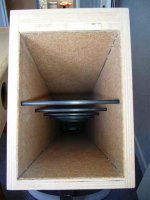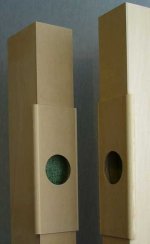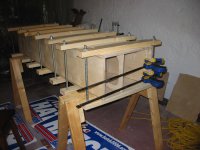I am building a BIB for fx207es out of 3/4 birch ply.
It is a pretty big box, 8.5 x 12.5 x 81 inches inside dimensions.
I am thinking of bracing the front and back panels.
Should I bother?
Will it screw up the sound?
It is a pretty big box, 8.5 x 12.5 x 81 inches inside dimensions.
I am thinking of bracing the front and back panels.
Should I bother?
Will it screw up the sound?
Yes double up the front and back. I feel the inner baffle provides enough of a brace for the sides from top to bottom. Enjoy!
Godzilla
Godzilla
Yes double up the front and back. I feel the inner baffle provides enough of a brace for the sides from top to bottom. Enjoy!
Godzilla
I was thinking of building a cross brace to fix in the middle going from the baffle to the back and the baffle to the front, by cutting a wedge of ply riddled with holes like I have seen in other speakers. Think that would work, or should I double up? I didn't plan on it, so doubling will decrease the inner volume some, probably more than cross bracing.
From my FE168ES BIB building experience, I found vibrations at the following places to be reinforced :
Speaker area => added 2x10mm" of medium => just perfect
The higher third of the sides => too bad, I discover the problem after the building, so I tried to include carbon tubes => It works, just the right amount of vibrations at high level 🙂
The inner bafle : mine is too thin => 🙁
I think it must be very rigid (compound materiel ?) to avoid "short circuit" for mediums & highs, letting them exiting at the top of the enclosure which is bad for the imaging !
I often think about cutting the back of my BIB to double the inner baffle and fill it with sand... not a joke !
Now, a good bracing "à la Planet10" planed before making is certainly preferable...
Sorry for my english, Babel Fish is my friend...
Speaker area => added 2x10mm" of medium => just perfect
The higher third of the sides => too bad, I discover the problem after the building, so I tried to include carbon tubes => It works, just the right amount of vibrations at high level 🙂
The inner bafle : mine is too thin => 🙁
I think it must be very rigid (compound materiel ?) to avoid "short circuit" for mediums & highs, letting them exiting at the top of the enclosure which is bad for the imaging !
I often think about cutting the back of my BIB to double the inner baffle and fill it with sand... not a joke !
Now, a good bracing "à la Planet10" planed before making is certainly preferable...
Sorry for my english, Babel Fish is my friend...
Attachments
I was thinking of building a cross brace to fix in the middle going from the baffle to the back and the baffle to the front, by cutting a wedge of ply riddled with holes like I have seen in other speakers. Think that would work, or should I double up? I didn't plan on it, so doubling will decrease the inner volume some, probably more than cross bracing.
I think you're suggesting something like a pair of longitudinal holey braces on either side of the internal fold panel?
I'd be inclined to overlap them vertically somewhat, and offset them horizontally from the center-line, so as to distribute the bracing effect over larger area of the 3 affected panels.
Attached sketch of BLH for an 8" driver that shows what I mean
Hint: it's a lot easier to fit these braces before buttoning up the last side panel
Attachments
post #6
chrisb
would you have the dem. for the box shown. would the fostex fe206es-r
work in these
thank you
chrisb
would you have the dem. for the box shown. would the fostex fe206es-r
work in these
thank you
I did a double thick front baffle. As you'll tend to hear resonances from the rear much less, I'm not sure a thick rear would be worth the weight. I also put a brace across the mouth, from side to side. It was maybe a foot long, and I cut a whole in the center. Not only is the mouth, and panels below it, on large BIB's ridiculously unsupported, but the brace provides a nice handle.
I thought of trying holey braces like I think you are suggesting. I'd seriously consider one in the mouth down to the bottom. It will provide much more stiffening than double thick panels. But, you still should consider doing something to address the sides, as they are larger and less supported.
Paul
Wild Burro Audio Labs - DIY Full Range Speakers
I thought of trying holey braces like I think you are suggesting. I'd seriously consider one in the mouth down to the bottom. It will provide much more stiffening than double thick panels. But, you still should consider doing something to address the sides, as they are larger and less supported.
Paul
Wild Burro Audio Labs - DIY Full Range Speakers
chrisb
would you have the dem. for the box shown. would the fostex fe206es-r
work in these
thank you
dimensioned sketch attached - note a couple of differences (double front baffle and tops), and excuse the metric
FWIW, these are for a quick & nasty pair of horns taken from a 2007 AudioXpress project, and no guarantees of performance are implied. From what I've heard from both 166 and 206ESR for which friends of mine have built the Fostex recommended BLH, I'd opine that no such thing as too much bracing for these drivers, but it could be possible to overdo the mass - even in plywood the result could well be excessive cabinet colorations from the lower mid bass down.
Attachments
Last edited:
Chrisb-
Yes, that is very much what i mean. Sounds like it would work, but, yes, needs to be installed before the final side is put on. Not an easy aftermarket modification...
pjanda1-
I was kind if thinking that the side panels would be adequately braced by the long baffle running from top to near bottom. I guess at the very top, a side to side cross brace could help, but do you think it is really necessary?
Yes, that is very much what i mean. Sounds like it would work, but, yes, needs to be installed before the final side is put on. Not an easy aftermarket modification...
pjanda1-
I was kind if thinking that the side panels would be adequately braced by the long baffle running from top to near bottom. I guess at the very top, a side to side cross brace could help, but do you think it is really necessary?
I think I misunderstood you. I was imagining a brace parallel to the sides, running between the back and the divider. I think you are asking about a brace from side to side? That is basically what I did, only mine was a foot long rather than running the entire length. I'm not sure any of us can say what is absolutely necessary, and certainly there are happy BIB owners with no bracing or double panels. I'm sure some bracing is good, but there is certainly a point of diminishing returns. I can tell you, however, that the sides of mine certainly vibrated more than I as comfortable with. However, I couldn't hear what I thought were any ill effects. So, I'd say do at least as much as I did. So long as you can lift them!
Paul
Wild Burro Audio Labs - DIY Full Range Speakers
Paul
Wild Burro Audio Labs - DIY Full Range Speakers
I think I misunderstood you. I was imagining a brace parallel to the sides, running between the back and the divider. I think you are asking about a brace from side to side? That is basically what I did, only mine was a foot long rather than running the entire length. I'm not sure any of us can say what is absolutely necessary, and certainly there are happy BIB owners with no bracing or double panels. I'm sure some bracing is good, but there is certainly a point of diminishing returns. I can tell you, however, that the sides of mine certainly vibrated more than I as comfortable with. However, I couldn't hear what I thought were any ill effects. So, I'd say do at least as much as I did. So long as you can lift them!
Paul
Wild Burro Audio Labs - DIY Full Range Speakers
You were right, a brace longitudinally, parallel to the sides bracing a couple of feet of the middle portion of the back to the baffle and similarly from just below the driver also to the baffle. Very much like the BLH drawing, although adapted.
With the large length of my BIB, I think it will help. 81 inches tall and the wife thinks it will look cool! Sweet....
>>> I'm sure some bracing is good, but there is certainly a point of diminishing returns. I can tell you, however, that the sides of mine certainly vibrated more than I as comfortable with. However, I couldn't hear what I thought were any ill effects.
Some neat bracing ideas! In the spirit of keeping things simple i just double up. You don't have to double up with .75" thick either... you could do a .25" 'veneer' layer on top which makes 1" thick walls. I think bracing by the mouth opening is a good idea but have not done it. Lucky for you your wife won't mind an 81" BIB... i'm sure you both will enjoy the sound for many years to come. BIBs have a way of finding their corners and staying a while.
Godzilla
Some neat bracing ideas! In the spirit of keeping things simple i just double up. You don't have to double up with .75" thick either... you could do a .25" 'veneer' layer on top which makes 1" thick walls. I think bracing by the mouth opening is a good idea but have not done it. Lucky for you your wife won't mind an 81" BIB... i'm sure you both will enjoy the sound for many years to come. BIBs have a way of finding their corners and staying a while.
Godzilla
Bofu TL bracing

I like to use dowels to cross-couple panels. Here the "Dowels" are just strips of ply, but they do the job. Nice thing too is that they act as dispersion devices for HF in the line (this is the Pass TL for the BOFU). I also doubled up the thickness on the driver mounting baffle, and laminated 1/4" premium ply over the lower quality ply used for the majority of the construction. You can see that the "dowels" couple to the front panel as well, so that's got "ribs" in effect.

I like to use dowels to cross-couple panels. Here the "Dowels" are just strips of ply, but they do the job. Nice thing too is that they act as dispersion devices for HF in the line (this is the Pass TL for the BOFU). I also doubled up the thickness on the driver mounting baffle, and laminated 1/4" premium ply over the lower quality ply used for the majority of the construction. You can see that the "dowels" couple to the front panel as well, so that's got "ribs" in effect.
I used a bunch of 2x4s and 5/8" threaded rod. Not quite as user friendly as proper clamps, but they sure don't break the bank. I even moved those "clamps" and use them to this day. I wouldn't trade my pair of quick clamps for anything, but I've managed to get by with a pair of them, a pair of ultra cheapies and the 2x4s.
Paul
Wild Burro Audio Labs - DIY Full Range Speakers
Paul
Wild Burro Audio Labs - DIY Full Range Speakers
Attachments
- Status
- Not open for further replies.
- Home
- Loudspeakers
- Full Range
- BIB bracing


